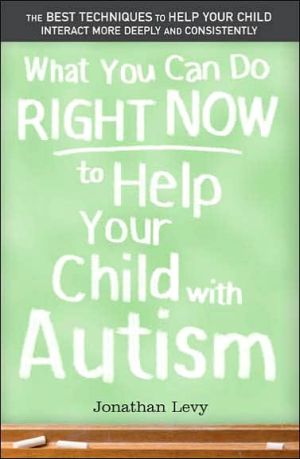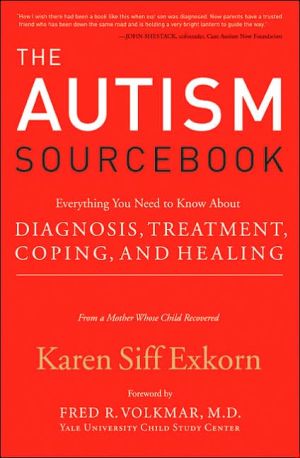What You Can Do Right Now to Help Your Child with Autism
"All children with autism have ways of dropping into their own world, leaving us behind for a minute, an hour, a day."\ This is the essence of autism: a disorder that is, at its heart, about interaction. Many of the symptoms associated with autism come from either a lack of paying attention to other people or a lack of interest in joining in with the rest of the world.\ Because this is the case, it is important that when you work with your child, you are addressing the core issue of autism:...
Search in google:
"All children with autism have ways of dropping into their own world, leaving us behind for a minute, and hour, a day."This is the essence of autism: a disorder that is, at its heart, about interaction. Many of the symptoms associated with autism come from either a lack of paying attention to other people or a lack of interest in joining in with the rest of the world. Because this is the case, it is important that when you work with your child, you are addressing the core issue of autism: your child, for one reason or another, is not spending enough time in our interactive world. What You Can Do Right Now to Help Your Child with Autism gives you the best techniques you can do - right now - to work with your child and draw him or her back into our interactive world. The ten techniques in the book are not just explained in detail, they are also illustrated by true stories of Mr. Levy's work with children with autism (and their parents). Topics include: •Don't React: How you respond to your child's behaviors can make all the difference. Learn why most people are ineffective in discouraging their child's 'problem' behaviors and how you can do it differently. •Make Eye Contact a Priority: Understand why eye contact is vital to your child's development and easy steps you can take to help your child to look more. •Join with the Stims: A different and powerful approach to your child's self stimulating and repetitious behaviors. •Respond Differently to Crying: Most of us give children great reasons to cry and act unhappy. Learn to teach your child a more effective way to communicate with you and the rest of the world.•Give Your Child as much Control as Possible: Most children with autism are told "No" much of the time by their parents, teachers, and family members. Make interacting with people more attractive to your child by allowing him to do more of what he wants and moving against him less. •Focus on Your Attitude: A hidden factor in your child's development is how you feel as you work with her. Learn why this is the case and how to feel better, more of the time. •Work One-On-One in a Non-Distracting Room: Why school isn't the best place for your child to develop and grow. Understand the three main factors in a successful educational environment. •Be Dynamic with Your Child: Enthusiasm matters to your child's growth. Learn the three tools you can use to demonstrate energy, excitement, and enthusiasm. •Get More Language: There are three categories of language ability, which does your child fit into? Master techniques that will enable your child to improve her speech, whatever her current level. •Make Sure Food Isn't Part of the Problem: An explanation of dairy and wheat intolerances, and why sugar isn't helping your child. Also, how to introduce new foods so he actually eats them. When parents feel their world spinning out of control, What You Can Do Right Now to Help Your Child with Autism puts the power back in their hands to work with--and help--their child.
Chapter Two: 2. Make Eye Contact a Priority The key to helping your child form deeper relationships\ The Issue with Jimmy\ Jimmy was a 6 year-old boy who I had worked with several times over the past two years. He had improved tremendously, going from no language to literally thousands of words. It was like he had been paying attention for all those years he was non-verbal, listening, thinking, learning, but with no way to get the words out. It seemed he had all those words in there, waiting until he could figure out how to say them. His family started the program and his language avalanched.\ His family had brought him back to ATCA for more training. I was the first to work with him this time. In the playroom, we drew a huge picture of superman, and Jimmy asked me what it would be like to fly. I was struck by how much he had changed. We were having a fascinating conversation! And yet...something was gnawing at me. Something was off. His parents watched me working with him, and when I came out of the room, they rushed up to me, excited about the session and how far Jimmy had come. I agreed with them, and went off to lunch, still unsure about what was wrong. Then it hit me: Jimmy had barely looked at me during our hour long session.\ The Most Intimate Thing in the World\ Autism is, at its core, a disorder that impairs interaction. Although some children with autism speak and some don't; some use the potty and some don't; and some can participate in an academic setting and some can't; all of them fundamentally have difficulties interacting with other people.\ The most direct — and most intimate - way we interact meaningfully with each other is through eye contact. Eye contact forces our attention to be on the person we are looking at.\ We know that people with autism remove themselves from "our world." So, it makes sense that they have poor eye contact. If they looked at other people in the eyes regularly, they'd be interacting more, and that is exactly what they are trying to avoid.\ The More They Look, The More They Learn\ The thing about eye contact is that everybody wants to put it on the back burner. Most parents believe that eye contact is not as important as learning speech, social skills, or even potty training. But the thing is, we get a huge chunk of our information about the world from what we see. Infants, for example, have remarkable eye contact. Babies are fascinated by people; they want to interact with us, they look into our eyes, and that's why they learn so much so fast.\ If you want your child to learn faster, then you have to help your child look more. Speech, social skills, potty training, everything goes faster when you have improved eye contact.\ If your child is watching you closely, then of course they are going to learn how to speak better. They are watching how you form the words. They are noticing all the subtleties of language and interaction that we couldn't explain if we tried. You are a model of how to be in the world. If your child is watching you, your child is learning from you. We had a saying in ATCA: the more they look, the more they learn.\ My Child Has Good Eye Contact\ Improving eye contact is vital to your child learning to be with other people in meaningful ways. Sometimes parents focus on some of the other challenges that face children with autism and de-prioritize eye contact. In some ways this is understandable: how do you really help your child to look more? It seems hard. Besides (many parents say), my child has good eye contact.\ Stop.\ No he doesn't.\ No, they say. My child really does have good eye contact.\ Trust me. He doesn't.\ The odds are, your child needs to work on his eye contact more than any other skill. Certainly there are exceptions to this. But a good 98% of you need to take this in: you must help your child to look more. This is top priority.\ My Cousin\ I went to a family function in Ohio a number of years ago. My Grandparents introduced me to Sally and Fred. Sally and Fred had a child with autism. Sally was a fourth cousin twice removed, so I had never met them before. They explained to me that Sam, their autistic son, was 28 and had a job. I was delighted to hear that he had done so well for himself.\ Fred confided in me that they wished Sam had more social skills, but he lived by himself, drove a car, and did fine. I asked if Sam was at the party and was told he was. Sally looked around the room and didn't see him anywhere.\ Then I had a thought. I went down to the basement. Sitting on the couch, watching TV, was a lone man.\ "I'm Jonathan," I said.\ "I'm Sam." He said this while still looking at the TV.\ Sam and I proceeded to have a 15-minute conversation about his life. I asked him many questions, and he answered them all. He did not look at me during the entire conversation, save once. That was when I said to him,\ "Could you look at me, Sam?"\ He did for the briefest of moments. Then his eyes darted back to the television.\ Sam is absolutely a success story. He has a job, he can drive, and he lives by himself. I know many of you would give your right arm for your child to have these things. But before you go amputating any body parts, it's important to note that there are also some things Sam didn't have, but could have had (with the right help):\ • A girlfriend\ • A best friend\ • Any friends at all\ • The ability to make friends Once you get past basic survival issues, many of the most precious things that we want in life involve how we relate to other people. The relationships that form our lives are how we define ourselves. And relationships are the most important thing in almost everybody's life.\ Charting Eye Contact\ It's important to get a strong sense of where your child's eye contact really is. Take the following chart and start observing your child in the same room with another person. Ask the person to do their best to play with your child. Observe for five minutes. Put a check mark in the chart every time your child looks at the other person in the eyes. Got that? Not in the chest or in their general direction, but actually in the other person's eyes. That's all that counts.\ There are two factors that are not captured in this chart: duration and spontaneity. Your child could look only seven times over the five minutes but look for so long each time that it's clear he has impressive eye contact. Spontaneity is the difference between a child looking based on his initiative vs. someone else initiating it. Ideally, you'd want your child to look of his own accord, but this is often something that has to be worked on.\ Watch Out for the Kids Who Talk\ Jimmy, the boy from the beginning of the chapter, had learned to speak in conversational sentences. He spoke so much that everyone got caught up in having meaningful and educational conversations with him and it pulled us away from working on eye contact with him. This happens all the time when children acquire speech skills: everyone gets so focused on talking that they assume the eye contact is there. If your child is talking to you, that's wonderful! Make sure he's looking too.\ After my session, the staff renewed our goal to help Jimmy with his eye contact. It improved quickly and he is in a regular school today, with no vestiges of autism. He has friends, and he knows how to make more.\ Techniques to Improve Eye Contact\ Now that you know why eye contact is so important, here's what you do to get more of it:\ Positioning Positioning is vital to encouraging eye contact. Sit in a chair and have a friend stand in front of you. Make eye contact with your friend when he or she is standing up. Note how this feels in your eye muscles. Now have your friend kneel down and be at or slightly below your eye level. Note how feels in your eyes.\ See the difference? Looking up creates a fair amount of strain on your eyes. Looking at or below your eye level is no strain at all. You want it to be easy for your child to look at you.\ So make sure you are at or below your child's eye level. This means you're going to be on your knees a lot. Later on, we'll get to creating an environment for your child that will include a soft floor to take care of your knees. Another aspect of positioning is making sure you are in your child's line of sight. This means you do not want to be behind your child or to your child's side. Instead, you want to be in front of your child, whenever possible.\ Put the Batman Up to Your Nose\ Children with autism look at a lot of things, just not people. Mainly, they look at what they're interested in. If you have a potato chip and give it to your child, chances are your child will look right at that chip. It makes sense because he needs to know where to reach for it. This is true for pretty much anything you give to your child (that he wants).\ There are some children who are so deeply absorbed in their repetitious behaviors that they don't look up at the object at all, instead reaching out (with almost a sixth sense) and grabbing the object without looking. If your child does this, it's because you always hold the object in the same place (relative to your child). All you have to do is throw your child a curveball by placing the drink (or toy or whatever) in a different spot than you normally do. Your child will reach for it, miss, and then have to look. If your child has excellent peripheral vision you'll have to hold the object a little bit behind him for this to work.\ Now that we know your child will look at everything you give to him, hold these objects up to your eyes as you deliver them to him. Your child will spy the object, and oftentimes will look at you as well. You've just created some eye contact! So hold that action figure (or drink or carrot or whatever) right on the bridge of your nose between your eyes, two inches in front of your face. You're helping your child immensely just by doing this.\ Get Excited! (celebration)\ Remember earlier in the book when we talked about how you react? You're going to put this into practice in several areas, and eye contact is one of them. This means when your child looks at you, celebrate it. You can do this in several ways:\ • Tell your child that you love it when she looks in your eyes\ • Let loose a fun and big exclamation\ • Smile big as a nonverbal way to celebrate the eye contact These are just some suggestions. Feel free to say or do whatever comes to mind. Your sincerity is powerful and your child can sense it. If you are excited about your child looking at you, express it in whatever way you feel it. If you are not excited about your child looking at you, don't fake the celebration. Instead, get in touch with how important it is for your child to look at you (and other people) and get excited!\ There are some children who look enough that if you celebrated all the times they looked at you, it would be overkill. Parents generally know it when they're overdoing it. In this case, instead of celebrating every look, wait a bit and mention to your child that he was looking really beautifully for the past few minutes.\ Also, don't interrupt your child (if he's talking) to tell him that his eye contact was great. In this case, wait until your child is done speaking and then tell him how much you appreciate the look.\ You Have to Ask for it\ When your child wants something from you, ask her to look at you before you give it to her. Say it clearly and directly: "If you want the truck, look in my eyes." It's okay if she doesn't look, and you'll still give her the object in the end, but you have to ask for it. Most importantly, you have to show her that when she looks at you she gets things faster than when she doesn't look at you.\ When your child wants something to eat, take a small amount of whatever it is she's eating (like one chip instead of the bag) and ask her to look at you before you give it to her. Stay standing so she can't reach the food. After she tries (whether she succeeds or fails, you want to reward effort) give her the food. When she eats it, go back and get another small amount of food. Request her to look again. This is much better than just giving her the whole bag of potato chips, because you get several requests in instead of just one.\ Working on the Docks\ Sometimes people ask: "How does it help a child to look at you when they weren't actively choosing to do so?" The answer is that it's similar to working on the docks. When you work on the docksyou're generally doing it for one reason: money. But you can't help but work your arm muscles as you lift all sorts of boxes and things. So even though you aren't trying to build up your arm muscles it happens anyway. You're working the muscles so they get stronger. You might get a better workout than the guys who go to the gym three times a week and eat Powerbars and have cool duffel bags and everything.\ Similarly, your child is building up the 'muscle' to improve eye contact even though she doesn't mean to working on it. Just by doing it more than normal she gets better at it, just as the dock worker gets stronger after a month on the job.\ To Review\ • Eye contact is vital to your child's development.\ • It's the heart of interaction.\ • The more they look, the more they learn.\ • Mostly, we delude ourselves about the level of our child's eye contact.\ • Position for it.\ • Hold objects up to your eyes.\ • Celebrate looking.\ • Ask for it.\ • Feel appreciation when your child looks at you.\
Dedication vAcknowledgments viPreface viiWhy You Should Listen ixThe 10 Things xiiDon't React 1Make Eye Contact a Priority 13Join with the Stims 27Respond Differently to Crying 51Give Your Child as Much Control as Possible 65Focus on Your Attitude 77Work One-on-One in a Non-Distracting Room 91Be Dynamic with Your Child 109Get More Language 121Make Sure Food Isn't Part of the Problem 151Conclusion 165Autism Treatment Center of America Fact Sheet 16710 Things Seminar 169Index 171About the Author 178







